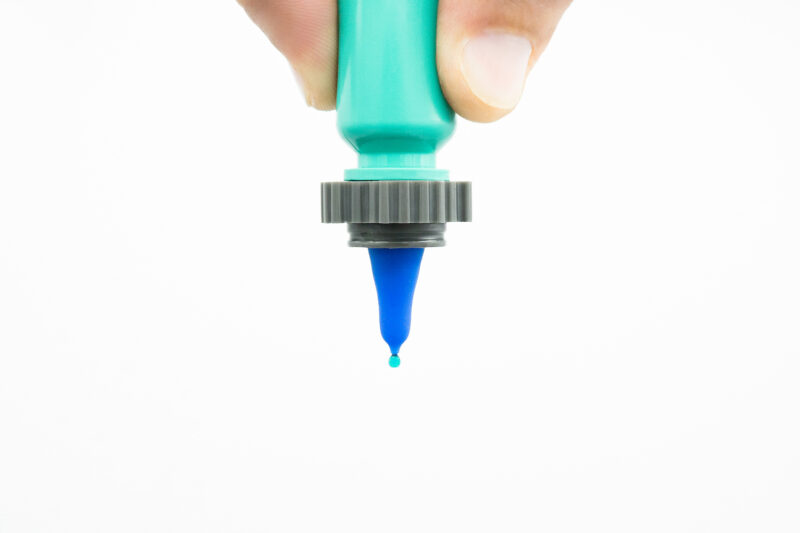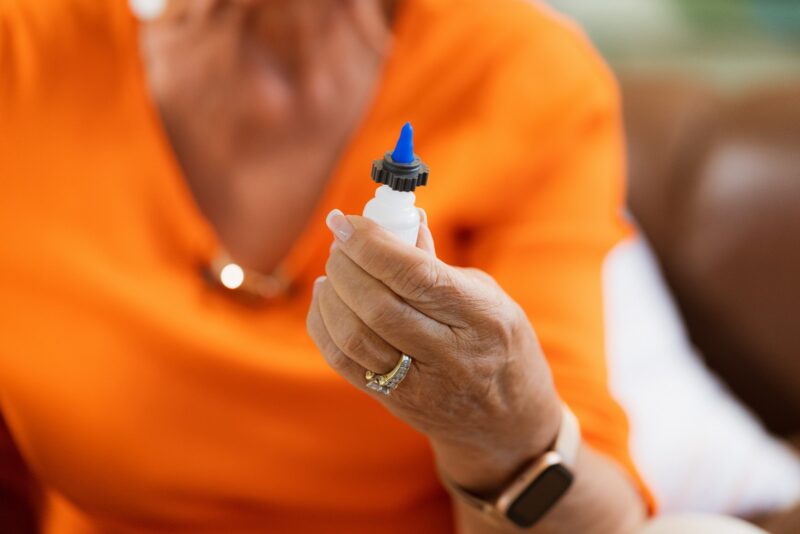The number of ophthalmological patients worldwide is estimated to exceed 1 billion. Accordingly, the eye drop market size is estimated at around 30 trillion won as of 2023, and particularly in countries that have entered an aging society, the demand for ophthalmological treatment medicines continues to increase.
The medical device startup Nanodropper was established with the goal of efficient eye drop usage and reducing side effects, and is throwing its hat into the Korean market based on technology recognized in the United States.

Nanodropper provides solutions utilizing micro-volume delivery technology to improve chronic eye disease treatment standards. This technology resolves the inefficiency and waste issues of existing eye drop usage methods, enabling patients to manage their eye health more safely and efficiently.
Nanodropper developed an innovative adapter to solve the problem of most eye drop bottles dispensing excessive medication. Currently, eye drop bottles can administer up to five times more medication at once, which not only wastes costs but also causes side effects such as dizziness, headaches, and blood pressure changes due to systemic absorption.
The Nanodropper adapter is a Class 1 medical device that can be easily mounted on standard eye drop bottles and is designed to deliver precisely smaller micro-droplets. This extends the usage period of eye drop bottles by up to three times and significantly reduces medication waste and side effect occurrence rates.
Nanodropper confirmed significant therapeutic effects through clinical trials, especially for glaucoma patients. Riding on these results, the company plans to go beyond developing cutting-edge technology to provide patient-centered, affordable, and practical solutions, and increase accessibility compared to existing expensive treatment alternatives. Currently, Nanodropper has been adopted by famous medical institutions such as Mayo Clinic and Johns Hopkins Hospital, as well as over 2,800 hospitals and clinics in the United States.
For Nanodropper, Korea is an attractive market characterized by an aging population, increasing ophthalmological patient numbers, high eye drop costs despite insurance coverage, and a proactive tendency to quickly accept innovative medical technologies. Nanodropper aims to rapidly occupy market share in Korea by emphasizing cost reduction and treatment efficiency.
Adopting a B2G model suitable for the Korean market, Nanodropper plans to receive insurance coverage approval for its product by early 2025 through collaboration with the National Health Insurance Service (NHIS). The company has obtained Class 1 medical device approval from the Ministry of Food and Drug Safety (MFDS) and is seeking hospitals to conduct clinical trials and economic impact analyses for full product distribution. They are also planning to attract investment for market expansion.
Nanodropper entered the Korean market through the ‘K-Startup Grand Challenge 2024‘ program that helps overseas startup teams enter Korea. The Korean government is making efforts such as opening a Global Startup Center (GSC) this year and creating a special startup visa for attracting overseas talent to help both domestic startup teams go global and foreign startup teams enter the domestic market.

Allisa Song, CEO of Nanodropper, stated, “Our entry into the Korean market will be an important opportunity to expand our presence in Asia and increase global recognition and influence,” and revealed the vision to “provide Korean customers with a safer and more cost-efficient eye health management solution and establish ourselves as global leaders in precise eye drop delivery technology.”
What problem are we trying to solve?
Current eye drop bottles dispense an excessive amount of eye drops, administering up to 5 times the volume of a human eye. This results in excessive medication use and waste, which is inefficient and increases the cost burden on users. Especially in Korea, eye drops are often expensive, with patients still incurring significant costs even after insurance coverage. Moreover, this over-administration can lead to unintended systemic absorption and side effects. This can cause harmful side effects such as dizziness, headaches, and even blood pressure changes. All these factors lead to reduced treatment compliance, suboptimal treatment results, medication waste, and increased burden on the medical system.
How do we solve this problem?
We solve the problem through the Nanodropper adapter. Our product is designed to be mounted on standard eye drop bottles, delivering medication in much smaller and more precise micro-droplets. The Nanodropper adapter extends the eye drop bottle’s lifespan by three times, minimizing waste. This solution has been clinically proven superior to current standard treatments, showing improved treatment outcomes for glaucoma patients and effectively addressing premature bottle depletion and reducing side effect rates. Our adapter has the potential to save healthcare systems billions of dollars.

What is our competitive advantage compared to competitors? What are our technological advantages?
Nanodropper is a practical solution helping patients manage their eye health. It is the first and only commercial adapter designed to simultaneously reduce droplet size and eye drop costs. Previous attempts to solve oversized eye drop problems were often costly, difficult to manufacture, or complete packaging solutions incompatible with existing market medications. Our competitive advantages lie in affordable pricing, adapter compatibility with widely used eye drop bottles, and user-considered characteristics – such as soft medical-grade silicone tips and a unique high-contrast color combination designed to aid aiming.
What product/service do we provide? What is our current status?
The Nanodropper adapter is a sterile Class 1 medical device delivering micro-droplets. This micro-drop adapter consists of three components: a tip, base, and cap. The flexible medical-grade silicone tip generates 10-15uL droplets, which is approximately ⅓ of the original droplet size. The tip connects to a plastic base with internal threading, mounted where the original cap was attached. Finally, a pop-off cap covers the silicone tip to prevent contamination. Users simply replace their existing eye drop cap with the adapter for immediate use.
Currently, our product is used in over 2,800 hospitals and clinics across 50 U.S. states. Notable customers include renowned medical institutions like Johns Hopkins Hospital and Mayo Clinic. Our device is also installed on the International Space Station (ISS) for NASA testing. In the U.S., patients can also directly order through our website and other online platforms.
In Korea, it was approved as a Class 1 medical device by the Ministry of Food and Drug Safety (MFDS) in October 2024. It is not currently covered by insurance, but we plan to receive insurance approval by early 2025 to make it affordable for everyone in Korea.
What is the target market size and who are the core customers?
Our target market includes individuals who regularly use eye drops, particularly those with chronic eye conditions such as glaucoma, dry eye, uveitis, and related disorders. The global ophthalmological medical device market is substantial, worth 71.5 trillion won, with the Asian market at 14.95 trillion won and the Korean market at 7.15 trillion won.
Why are we entering the Korean market? What do we want to do in the Korean market?
We have three main reasons for entering the Korean market. First, as Korea transitions into an aging society, the number of people experiencing eye conditions is increasing, creating a steady demand for effective, affordable, and precise eye care solutions. This market environment opens opportunities for our product to provide significant value.
Additionally, Korea is a leading country in global medical fields, with an open attitude towards innovative medical products and technologies. With a world-class medical system and the world’s second-best insurance system, Korea provides very favorable conditions for Nanodropper adapters to successfully establish themselves.
Lastly, by entering the Korean market, we aim to establish a strong presence in the Asian region, expand our customer base, and create an important platform to increase brand recognition.
Our goal is to provide Korean customers with a safer and more cost-effective method of managing eye health, while simultaneously positioning Nanodropper as a leader in precise eye drop delivery technology.
What is our business model?
Our business model in Korea adopts a B2G (Business-to-Government) approach, through which we aim to directly negotiate with the National Health Insurance Service (NHIS) to secure insurance coverage for our service and product. Our objective is to minimize patient out-of-pocket expenses.

What have been our team’s achievements? What are our achievements in entering the Korean market?
Our device has been approved as a Class 1 medical device by the Ministry of Food and Drug Safety (MFDS) and is currently under patent examination. We have also signed MOUs with import/distribution companies and manufacturing companies, and have received support from Korean ophthalmologists who want to provide our device to their patients. Join us on our journey.
What is our team’s competitive advantage?
The four founders of Nanodropper united with a shared mission to address health inequalities. The company was founded after seeing news articles about the economic difficulties and oversized eye drops creating barriers to treatment for glaucoma patients in the United States. The team established a data-driven company and a foundation for evidence-based decision-making based on outstanding technical and scientific backgrounds.
The company founders are authors of peer-reviewed papers in ophthalmology, pharmacology, and neuroscience, with learning experiences from Mayo Clinic, Harvard, Brown, and the University of Washington. They also have startup experience in clean tech and careers at companies like SpaceX, Kestra Medical, and Spacelabs. Their medical field experience and flexibility in strategic planning position them uniquely to realize the company’s vision, push a new standard for medical devices with value-based solutions, and set new treatment standards in chronic eye disease management.
What do we currently need most for entering the Korean market?
To receive insurance coverage in the Korean market, we must obtain approval from the Health Insurance Review & Assessment Service (HIRA). We are also looking for partner hospitals to conduct clinical trials and economic impact analyses. Lastly, we are seeking investment to promote growth in the Korean market. The Nanodropper adapter made its TV debut on Amazon Prime Video’s show ‘Buy It Now’ (Season 01, Episode 04) last month. We appreciate your interest in our social accounts and product information.
MORE FROM THE POST
- [Korean Startup Interview] CrossPoint Tackles Key ADC Market Issue with Fc Silencing Tech, Attracting Global Biotech Interest
- [Korean Startup Interview] SimfliBIO Challenges NGS with Advanced Liquid Biopsy for Global Cancer Diagnostics Market
- [Korean Startup Interview] Beyondmedicine, Pioneering World’s First Digital Therapeutic for TMJ Disorders
- [Korean Startup Interview] Peptirna Therapeutics Aims for Global siRNA Market with Peptide Delivery Platform
- Nanodropper Wins 2nd Place at K-Startup Grand Challenge, Introducing Groundbreaking Eye Care Innovation
- BioHealth
- go Korea
- Interview
- K-Startup Grand Challenge
- K-Startup Grand Challenge 2024
- Korea
- Nanodropper
- WOWTALK
Share
Most Read
- 1
- 2
- 3
- 4
- 5



Leave a Reply